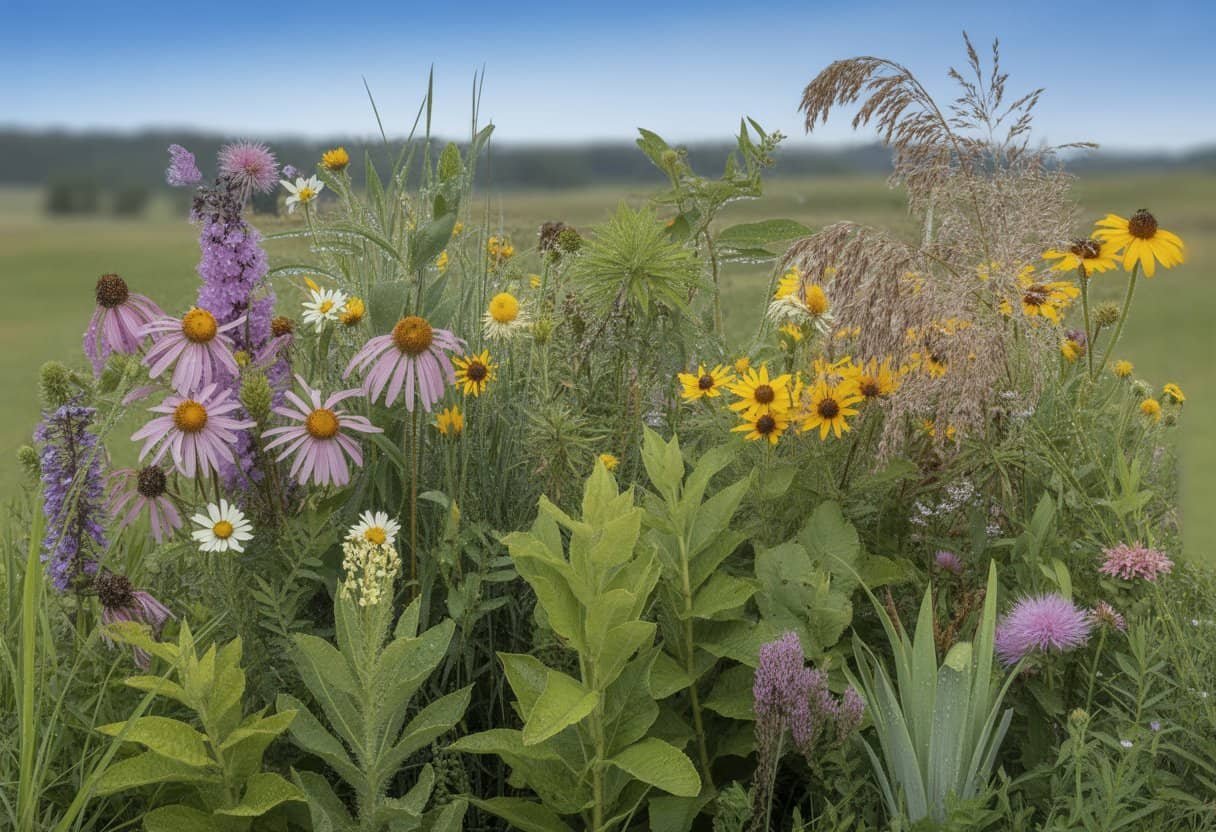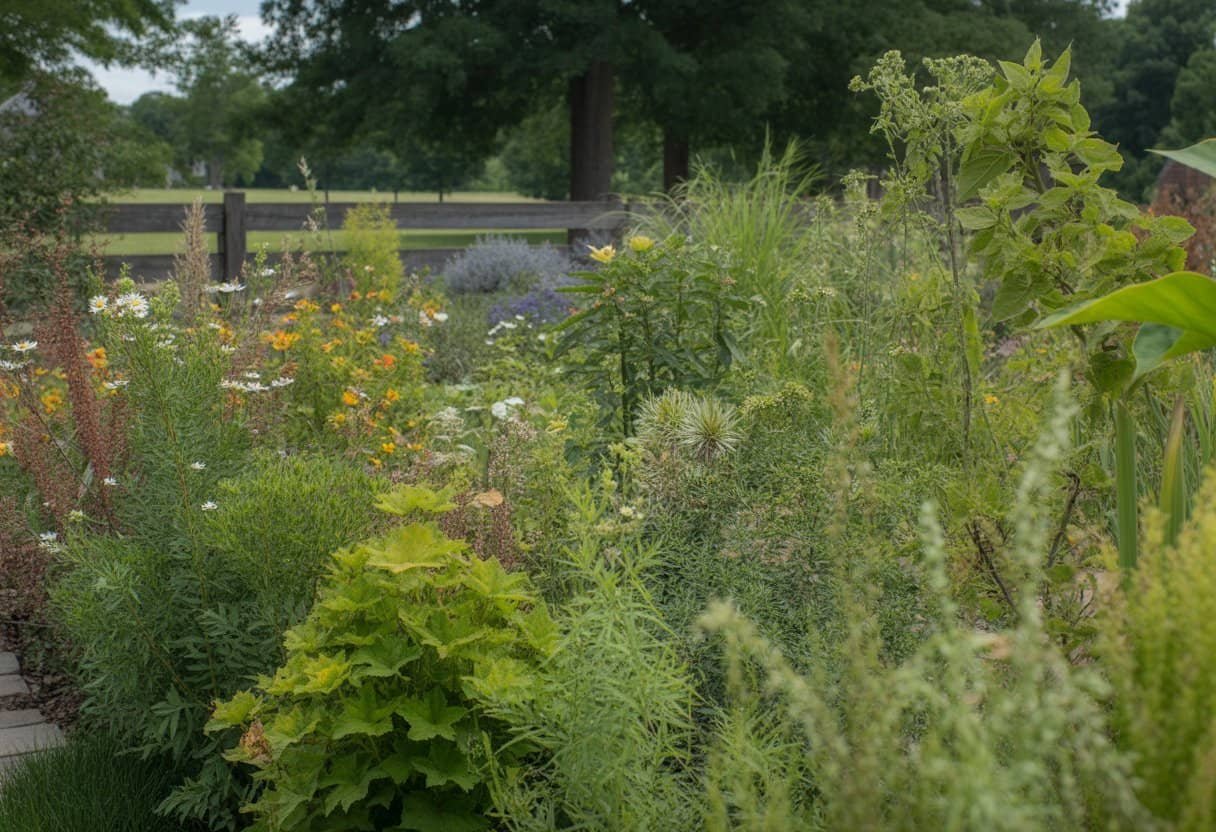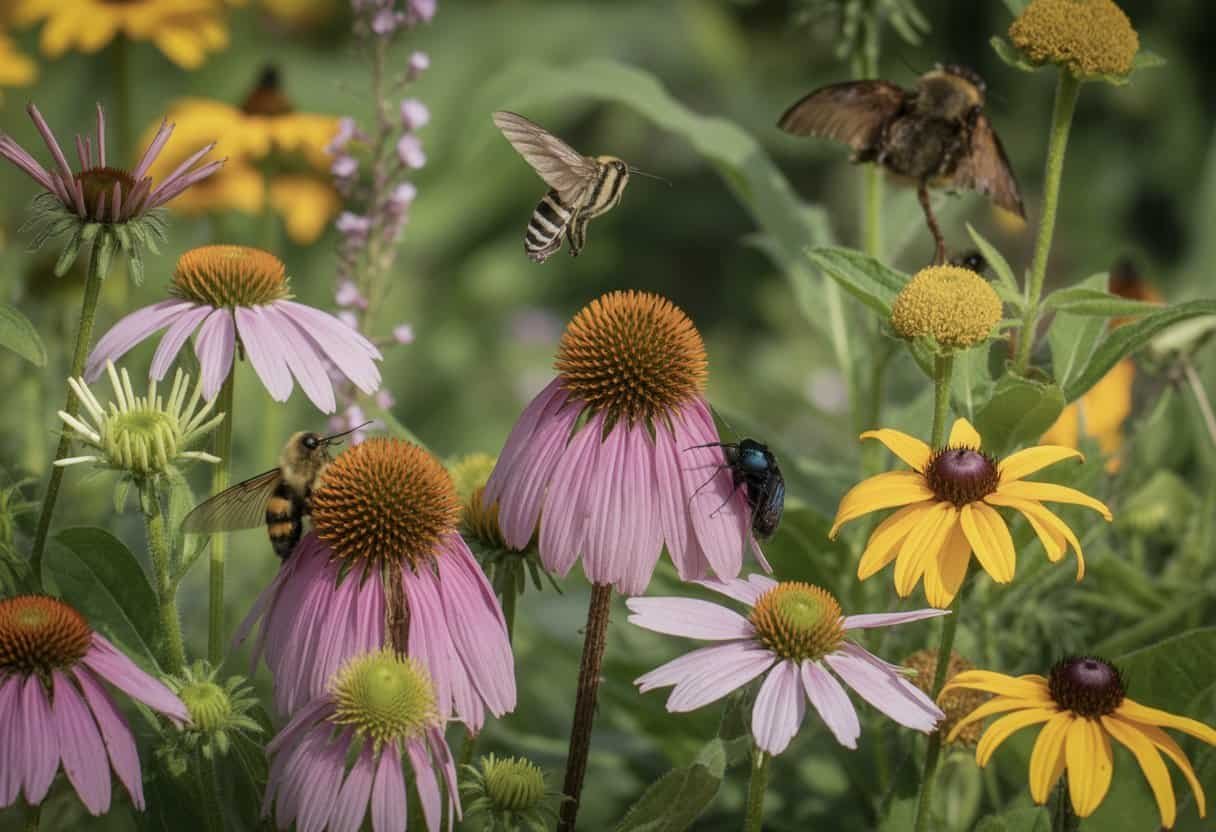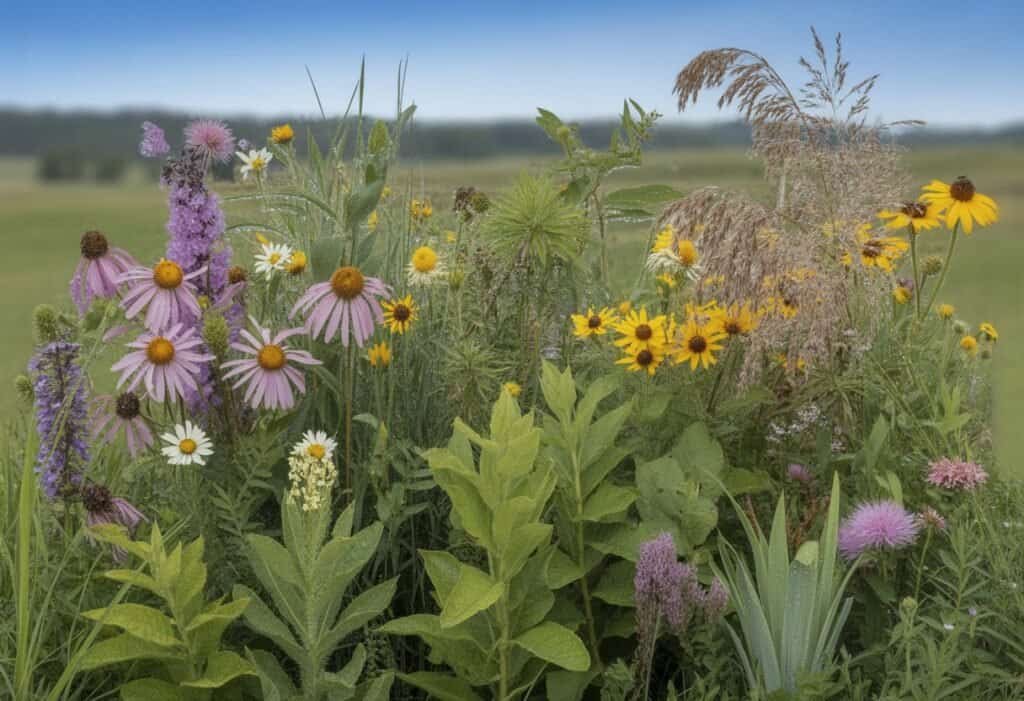Missouri native plants offer beauty and ecological benefits for local gardens. These plants evolved over thousands of years to thrive in Missouri’s climate, soil, and alongside local wildlife.
Using native plants in your Missouri garden supports local ecosystems. You can also reduce the need for extra water, fertilizers, and pesticides.

These adaptable plants come in many varieties, from the vibrant purple coneflower to the majestic oak tree. Native plants create habitat for birds, butterflies, and helpful insects.
They also help prevent soil erosion and improve water quality across Missouri’s landscapes.
Key Takeaways
- Missouri native plants need less maintenance and provide habitat for local wildlife.
- Choosing native species helps conserve water and reduces chemical use in your garden.
- Native plant communities strengthen local ecosystems and preserve Missouri’s natural heritage.
Overview of Missouri Native Plants
Missouri’s landscape is home to a rich variety of native plants. These plants shape local ecosystems and provide resources for wildlife.
They also contribute to the state’s unique natural heritage.
Defining Native Plants
Native plants grow naturally in a region without human introduction. In Missouri, these species developed over thousands of years and adapted to local soil and climate.
The Missouri Department of Conservation lists about 2,000 native plant species statewide. These include trees like eastern redbud, flowering dogwood, prairie grasses such as big bluestem, and wildflowers like Missouri primrose.
Native plants evolved alongside local wildlife, creating close relationships with native insects, birds, and mammals. Many Missouri natives handle local weather extremes, including drought, flooding, and temperature swings.
Their deep roots help them survive tough conditions and stabilize soil.
Benefits to Ecosystems
Native plants provide habitat and food for Missouri wildlife. Their seeds, berries, nectar, and leaves feed birds, mammals, and insects all year.
Missouri’s native plant communities support over 400 native bee species and many other beneficial insects. These insects, in turn, feed birds and other wildlife, supporting a healthy food web.
Native plants’ deep roots prevent soil erosion along Missouri’s waterways. They filter water as it moves through soil, improving water quality in streams, rivers, and groundwater.
They act as carbon sinks and help reduce climate change impacts. When planted in the right spot, native plants need no fertilizers or pesticides, which reduces chemical runoff.
Missouri Plant Diversity
Missouri’s location creates remarkable plant diversity. The state sits at the meeting point of eastern woodlands, western prairies, and southern ecosystems.
The Ozark region is rich in biodiversity, with many species found nowhere else. Ozark witch hazel and Missouri evening primrose are two examples that thrive in this area.
Missouri’s prairies once covered about one-third of the state. Today, less than 1% remains, making prairie plants like compass plant and prairie blazing star rare and threatened.
Wetland plants such as buttonbush and swamp milkweed flourish in Missouri’s marshes. These species filter pollutants and provide habitat for amphibians and waterfowl.
Choosing the Right Native Plants for Missouri Gardens

Native plants adapt well to Missouri’s climate and soil. They need less maintenance and support local wildlife.
They also add beauty and practical benefits for gardens of any size.
Popular Missouri Native Flowers
Purple coneflower (Echinacea purpurea) has purple blooms that attract butterflies from June to August. These drought-resistant flowers grow 2-4 feet tall and like full sun to partial shade.
Black-eyed Susan (Rudbeckia hirta) produces yellow flowers with dark centers from June to September. They grow easily in average soil and full sun.
Missouri primrose offers bright yellow blooms that open in the evening. This plant tolerates poor soil and drought.
Wild bergamot (Monarda fistulosa) shows lavender-purple flowers that attract pollinators. It grows 2-4 feet tall and prefers full sun to partial shade.
Popular Native Flowers for Missouri Gardens:
- Butterfly milkweed – Orange blooms, June-August
- Cardinal flower – Bright red, July-September
- New England aster – Purple flowers, August-October
- Wild columbine – Red and yellow, April-May
Trees, Shrubs, and Vines
Redbud trees bloom with pink-purple flowers in early spring before leaves appear. These small trees (20-30 feet) suit small yards.
Elderberry shrubs have white flower clusters and dark purple berries that birds love. They grow 5-12 feet tall and prefer moist soil.
Virginia creeper is a vine that climbs walls or covers ground. Its leaves turn bright red in fall for dramatic color.
Serviceberry trees offer white spring flowers, edible berries in summer, and orange-red fall color. They reach 15-25 feet and attract birds.
Missouri hazelnut forms a dense shrub 10-15 feet tall with edible nuts. It adapts to many soil types and feeds wildlife.
Native Woody Plants by Size:
| Plant Type | Examples | Height | Features |
|---|---|---|---|
| Small Trees | Redbud, Serviceberry | 15-30 ft | Spring flowers |
| Shrubs | Elderberry, Hazelnut | 5-15 ft | Wildlife value |
| Vines | Virginia creeper, Trumpet vine | Climbing | Fall color |
Ground Cover and Lawn Alternatives
Wild ginger makes a good shade ground cover with heart-shaped leaves. It grows 4-6 inches tall and spreads slowly.
Prairie dropseed grass has a soft, fountain-like look and reaches 2-3 feet tall. Its fine texture and golden fall color add year-round interest.
Wild strawberry has small white flowers in spring and tiny edible berries. It spreads by runners to form a 3-4 inch tall mat.
Sedges give a grass-like look for moist areas. Pennsylvania sedge grows 6-8 inches tall and tolerates dry shade.
Buffalo grass needs little mowing or watering once established. This prairie grass grows 4-8 inches tall and forms a dense mat that crowds out weeds.
Benefits of Native Ground Covers:
- Reduce lawn maintenance time and costs
- Eliminate need for fertilizers and pesticides
- Provide habitat for beneficial insects
- Prevent soil erosion on slopes
Supporting Pollinators with Native Flora

Missouri’s native plants are vital for local pollinators. These plants and their pollinator partners evolved together, forming communities that support biodiversity.
Attracting Bees and Butterflies
Missouri is home to over 450 native bee species and 200 butterfly species. Many of these insects rely on native flowers that fit their feeding needs.
For bees, plant purple coneflower (Echinacea purpurea) for nectar and pollen. Wild bergamot (Monarda fistulosa) attracts both bees and butterflies with fragrant blooms.
Native bees especially value early spring flowers like wild geranium.
Butterflies need both nectar and host plants. Milkweed (Asclepias species) is the only host for monarch butterflies. Black-eyed Susans (Rudbeckia hirta) attract many butterflies with their bright petals.
Plant these natives in clusters of at least 3-5 of the same species. Groupings make it easier for pollinators to find them.
Creating Habitat for Hummingbirds
Ruby-throated hummingbirds, Missouri’s only native hummingbird, need tubular flowers that fit their bills. These birds need high-energy nectar.
Top Missouri natives for hummingbirds:
- Cardinal flower (Lobelia cardinalis) – Bright red blooms July-September
- Wild columbine (Aquilegia canadensis) – Spring blooming with unique shape
- Royal catchfly (Silene regia) – Rare prairie plant with bright flowers
- Trumpet honeysuckle (Lonicera sempervirens) – Vine with orange-red blooms
Hummingbirds prefer red and orange flowers, which stand out to them. Plant these natives at different heights to create vertical feeding zones.
Avoid using pesticides on or near hummingbird plants. These birds eat small insects, and chemicals can harm both their food and the birds.
Bloom Seasons for Pollinators
A pollinator-friendly garden needs blooms from early spring to late fall. This ensures food for pollinators during their active seasons.
Spring (March-May):
- Wild plum (Prunus americana)
- Wild geranium (Geranium maculatum)
- Golden Alexander (Zizia aurea)
Summer (June-August):
- Purple coneflower (Echinacea purpurea)
- Butterfly weed (Asclepias tuberosa)
- Wild bergamot (Monarda fistulosa)
Fall (September-November):
- New England aster (Symphyotrichum novae-angliae)
- Goldenrod (Solidago species)
- Aromatic aster (Symphyotrichum oblongifolium)
Include at least three plants from each bloom period. This provides a steady food supply for bees and butterflies throughout the growing season.
Landscaping and Design Using Missouri Native Plants
Native plants create low-maintenance, beautiful landscapes that support wildlife. These plants have adapted to Missouri’s climate over thousands of years.
Design Principles and Considerations
Start by assessing your site conditions. Different Missouri natives thrive in different places—some need full sun, others prefer shade.
Soil type also matters.
Match plants to your conditions:
- Full sun: Coneflowers, blazing stars, prairie grasses
- Partial shade: Wild ginger, columbine, woodland phlox
- Full shade: Ferns, wild hydrangea, woodland sedges
Consider mature plant sizes when placing them. Put taller plants like Joe-Pye weed in the back, and shorter plants like wild geranium in front.
Group plants with similar water needs together. This method, called hydrozoning, makes watering more efficient and prevents overwatering.
Garden Layouts and Themes
Missouri native plants fit many landscape themes. A prairie garden uses grasses like little bluestem with colorful wildflowers for a meadow look.
Popular native garden themes:
- Butterfly garden: Milkweed, asters, liatris
- Rain garden: Cardinal flower, iris, sedges
- Woodland garden: Trillium, bloodroot, ferns
Plant in drifts or clusters instead of single plants. Groups of 3-7 of the same species create more impact.
Layer your plantings with groundcovers, mid-height perennials, and taller shrubs or trees. This mimics nature and provides habitat for wildlife.
For small spaces, use native container gardens with plants like purple coneflower, prairie dropseed, and aromatic aster.
Native Plant Conservation in Missouri
Missouri’s native plants face threats like habitat loss, invasive species, and climate change. Conservation efforts throughout the state work to protect these important species and the ecosystems they support.
Role in Preserving Biodiversity
Native plants form the foundation of Missouri’s ecosystems. They provide essential habitat and food for wildlife, including pollinators like bees and butterflies.
Missouri is home to over 2,000 native plant species. Many of these plants have adapted to local conditions over thousands of years.
These adaptations make native plants resilient and well-suited to the state’s climate. Conservation areas throughout Missouri protect rare plant communities.
The Missouri Department of Conservation manages more than 1,000 natural areas. These areas preserve native plant biodiversity.
Prairie restoration projects have become increasingly important. Less than 1% of Missouri’s original prairie remains.
These projects reintroduce native grasses and wildflowers. Native plants once covered much of the state.
Missouri Department of Agriculture Initiatives
The Missouri Department of Agriculture works with farmers and landowners to integrate native plants into agricultural landscapes. Their programs promote sustainable farming practices that protect soil health and preserve native plant species.
The Grow Native! program, supported by the Department of Agriculture, educates Missouri residents about the benefits of native plants. This initiative provides resources for gardeners, farmers, and landscapers interested in using native species.
Grant programs help fund conservation efforts across the state. The Department offers financial assistance to projects that protect threatened plant communities and restore damaged habitats.
Research partnerships with universities track the status of rare plant populations. These collaborations identify which species need the most protection and develop effective conservation strategies.
Managing Threats: Invasive Species and Garden Challenges
Missouri native gardens face ongoing challenges from invasive species. These invaders disrupt natural ecosystems and compete with local plants.
Proper identification and control methods are essential for maintaining healthy native plant communities. Gardeners need to stay vigilant to protect their landscapes.
Identifying Invasive Plants
Invasive plants in Missouri include Bush Honeysuckle, Bradford Pear, and Japanese Honeysuckle. These aggressive species spread rapidly and outcompete native plants for resources.
Bush Honeysuckle forms dense thickets that block sunlight from reaching native seedlings. Birds eat its red berries and spread the seeds across the landscape.
Bradford Pear trees escaped from landscaping and now invade natural areas. Their weak branches and dense growth habits cause problems in both urban and rural settings.
Japanese Honeysuckle vines climb and strangle native trees and shrubs. Their evergreen nature gives them an advantage over dormant native species during winter.
Look for plants that spread aggressively, leaf out earlier than natives, or resist natural controls like insects and disease. Plants that form monocultures where diversity once existed are likely invasive.
Prevention and Control Methods
Preventing invasive plants begins with careful plant selection. Always research new additions to your garden and choose certified native species from reputable nurseries.
Manual removal works well for small infestations. Pull invasive plants when soil is moist and remove the entire root system.
Dispose of removed plants in sealed bags to prevent spread. For larger problems, selective herbicides may be necessary.
Apply herbicides carefully to target plants during their active growing season:
- Cut-stump method: Cut stems and immediately apply herbicide.
- Foliar spray: Apply to leaves during active growth.
- Basal bark treatment: Apply to lower stems of woody plants.
Regular monitoring helps catch new invasions early. Inspect your garden monthly during the growing season to identify and remove unwanted seedlings before they establish.
Community efforts like volunteer removal days can tackle larger infestations in natural areas. These group activities help restore native plant communities and educate participants.
Building Community and Resources for Native Plant Enthusiasts
Missouri offers many ways for plant enthusiasts to connect and learn about native plants. These communities and resources help gardeners at all levels succeed with local species.
Local Partners and Organizations
Missouri has several organizations dedicated to native plant preservation and education. The Missouri Prairie Foundation works to protect and restore prairie ecosystems.
Their Grow Native! program offers plant lists, supplier directories, and professional certifications. The Missouri Department of Conservation maintains demonstration gardens throughout the state.
Visitors can see native plants in various landscape settings. The Department also publishes free guides for homeowners interested in wildlife-friendly yards.
Missouri Native Plant Society chapters meet regularly in regions across the state. These groups organize field trips, workshops, and plant sales.
Wild Ones chapters focus on promoting native landscaping practices. Members often share plants from their gardens, reducing costs for newcomers.
Educational Programs and Events
The Missouri Botanical Garden in St. Louis hosts regular native plant workshops, sales, and walking tours. Their Shaw Nature Reserve features extensive native plant collections and habitat restoration projects.
Native Plant Schools offered by conservation partners provide hands-on learning opportunities. These programs teach identification, maintenance, and design principles for native gardens.
Annual events like the Missouri Prairie Foundation’s Prairie Days and local Master Gardener Plant Sales allow enthusiasts to purchase native species and learn from experts.
Missouri Master Naturalist training provides in-depth education about native ecosystems. Graduates contribute volunteer hours to conservation projects and public education.
Online forums like the Missouri Native Plants Facebook group connect thousands of gardeners. Members share advice, photos, and resources specific to Missouri’s growing conditions.
Frequently Asked Questions
Many Missouri gardeners have questions about native plants. These plants offer many benefits and can thrive in the state’s unique climate and soil conditions.
What are the best Missouri native plants for landscaping purposes?
Purple coneflower serves as an excellent landscaping choice with its striking purple petals and orange center. This drought-resistant perennial attracts butterflies and birds.
Black-eyed Susan offers bright yellow flowers that bloom from June to October. It requires minimal maintenance and adapts to various soil types.
Butterfly milkweed produces vibrant orange blooms that attract monarch butterflies. This plant thrives in well-drained soil and full sun.
Little bluestem grass provides year-round visual interest with blue-green summer foliage that turns copper-red in fall. It works well as a border plant or in mass plantings.
How can I identify Missouri native plants and trees?
Leaf shape and arrangement serve as key identification features. Look at whether leaves grow opposite each other or alternate along stems.
Flower structure and color help identify many native plants. Missouri wildflowers often have distinct petal arrangements and bloom times.
Bark texture and color assist in tree identification. The shaggy bark of shagbark hickory or the smooth gray bark of beech trees provides clear indicators.
Field guides specific to Missouri flora offer detailed descriptions and images. The Missouri Department of Conservation provides free plant identification resources online.
Where can I purchase native plants suitable for Missouri climates?
Native plant nurseries specialize in locally grown species. Businesses like Missouri Wildflowers Nursery and Forest Keeling Nursery offer many options.
Conservation department plant sales occur throughout spring. These events provide affordable native plants and expert advice.
Local garden centers increasingly stock native options. Ask specifically for Missouri natives rather than general “wildflower” mixes.
Native plant societies often host member plant exchanges. The Missouri Native Plant Society organizes regional sales events during the growing season.
Which Missouri native plants thrive in full sun conditions?
Blazing star produces tall purple flower spikes that bloom from July to September. This plant attracts butterflies and tolerates drought once established.
Prairie dropseed grass forms elegant fountain-shaped clumps. Its fine-textured foliage turns golden in fall and emits a pleasant fragrance.
Wild bergamot, also called bee balm, displays lavender flowers that pollinators love. This mint family member adapts to various soils in full sun.
Compass plant can reach heights of 8 feet with yellow daisy-like flowers. Its deep taproot makes it extremely drought resistant once established.
Can you list common native flowers found in Missouri?
Wild columbine displays nodding red and yellow flowers in spring. This woodland beauty attracts hummingbirds and grows well in partial shade.
Cardinal flower produces brilliant red blooms on tall spikes. This perennial prefers moist soil and blooms late summer.
Missouri primrose offers large yellow flowers that open in the evening. This plant thrives in rocky, well-drained sites.
New England aster provides purple daisy-like flowers in fall. This late-season bloomer serves as crucial nectar for migrating monarch butterflies.
What are the benefits of cultivating native Missouri plants in my garden?
Water conservation stands out as a major benefit. Native plants develop deep root systems and need less watering once they are established.
Wildlife support increases with native plants. Local birds, butterflies, and beneficial insects rely on these plants.
Reduced maintenance saves time and resources. Missouri natives need less fertilizer and pest control than exotic species.
Erosion control improves with native plantings. Prairie plants like switchgrass have strong roots that hold soil well on slopes.


